Table of Contents
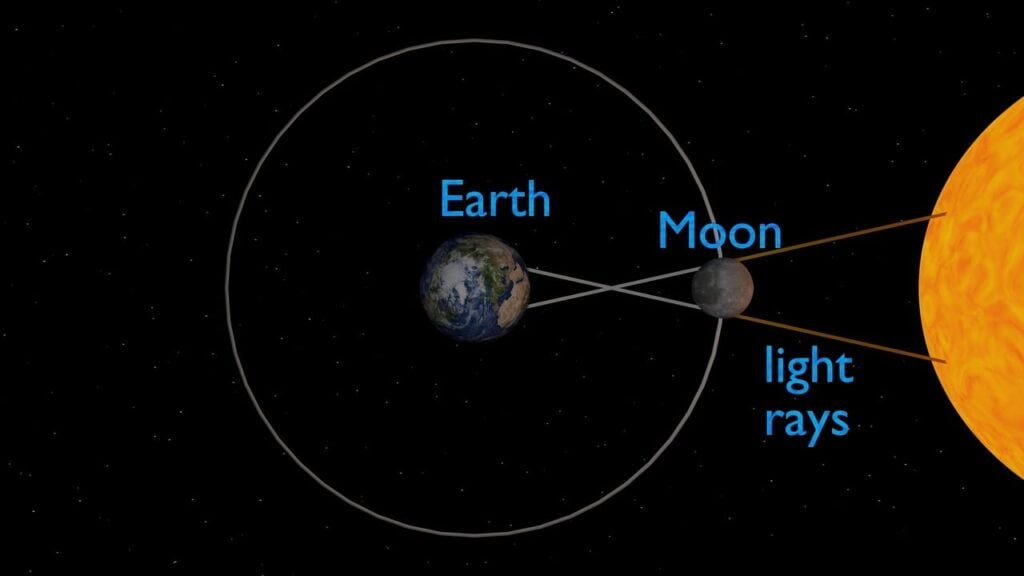
WHAT IS A SOLAR ECLIPSE
A solar eclipse happens when the Moon passes between the Earth and the Sun, blocking all or some of the Sun’s light. This casts a shadow on Earth, with the most dramatic event being a total eclipse, in which the Sun is entirely covered by the Moon for a short time. This only happens on rarely because the moon doesn’t revolve in the same plane as the Sun and Earth.
TYPES OF SOLAR ECLIPSE
As we told you earlier, the solar eclipse happens when Earth-Moon-Sun are in a straight line or the same plane. Depending on how the moon passes between the sun and earth, it can be classified as three types—
- Total Solar Eclipse
- Annular Solar Eclipse
- Partial Solar Eclipse
- Hybrid Solar Eclipse

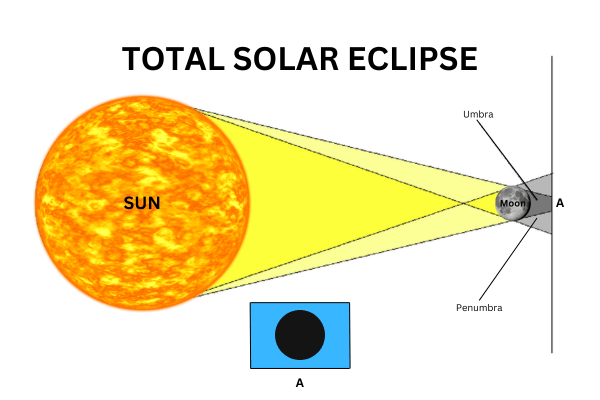
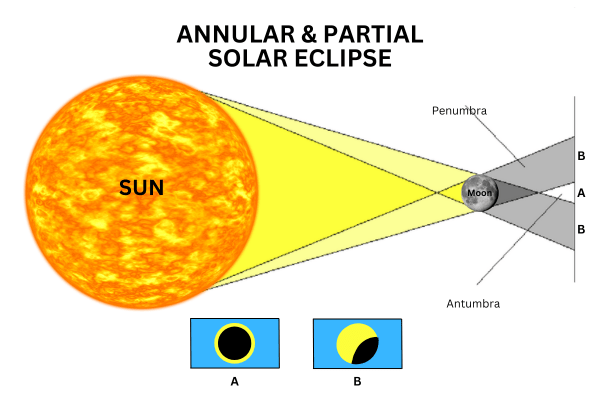
TOTAL SOLAR ECLIPSE
A total solar eclipse is a kind of solar eclipse that happens when the moon passes between the sun and earth by completely blocking the face of the sun. People who are in the centre of the moon’s shadow will experience a total solar eclipse. In this event, the sky will darken, and we can see the sun’s corona around the moon. By taking proper safety equipment, you may be able to see the sun’s outer atmosphere, which is also known as the corona.
ANNULAR SOLAR ECLIPSE
An annular solar eclipse is a type of solar eclipse that happens when the moon passes between the sun and earth but when it is at its farthest point from Earth. Because the moon is farthest away from Earth, it appears smaller than the sun. As a result, it’s not able to completely cover the sun. During an annular solar eclipse, the Moon appears as a black disc above a bigger, brighter disc, forming a ring around the Moon.
PARTIAL SOLAR ECLIPSE
A partial solar eclipse happens when the moon passes between the sun and earth, but in this type of solar eclipse, the Sun, Moon, and Earth aren’t perfectly lined up. As a result, a smaller part of the Sun is visible, whereas the blocked part appears dark. During a complete or ring-shaped solar eclipse, individuals located outside the region enclosed by the Moon’s inner shadow observe a partial solar eclipse.

HYBRID SOLAR ECLIPSE
A hybrid eclipse is the rarest of all eclipses because it transitions between a total eclipse and an annular eclipse. In a hybrid eclipse, certain areas on Earth will experience a total eclipse where the moon completely blocks the sun, while other regions will witness an annular eclipse.
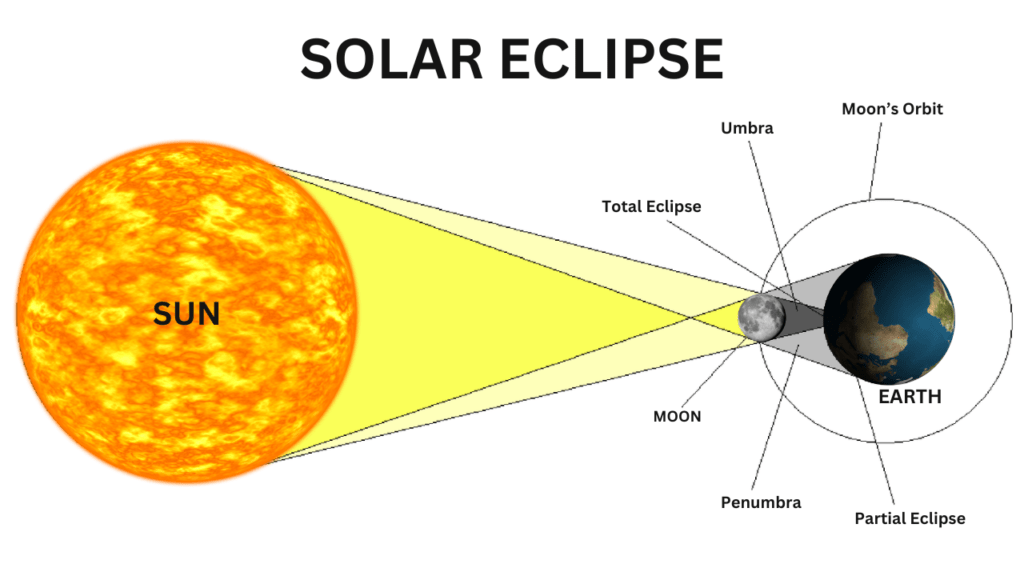
HOW SOLAR ECLIPSE OCCUR
During a solar eclipse, the Moon comes between the Earth and the Sun, blocking the Sun’s light either partially or fully for a temporary period. This event occurs when the Moon is in the new moon phase and directly aligns with the Sun and Earth. The occurrence of a solar eclipse requires the perfect alignment of the Sun, Moon, and Earth in a straight line, a condition referred to as “syzygy.”
Solar eclipses come in three main variations: total, partial, and annular. In a total solar eclipse, the Moon completely obscures the Sun, casting a shadow on a small part of the Earth’s surface and causing temporary darkness in that area. The umbra, which is the dark, central part of the shadow, results in a total eclipse for those within this area. The penumbra surrounds the umbra and allows for the visibility of a partial eclipse, as the Sun is only partially obscured. When an annular eclipse takes place, the Moon is positioned farther from Earth and appears smaller in the sky, thus not completely covering the Sun and leaving a bright ring, known as an “annulus,” around its edges. This coincident happens because, the Sun is approximately 400 times bigger than the Moon, but it is also roughly 400 times more distant, causing them to appear similar in size when viewed from Earth. This special alignment allows the Moon to sometimes obstruct the Sun’s light, resulting in the magnificent event of a solar eclipse.
Solar eclipses are not a monthly occurrence due to the Moon’s orbit around Earth being tilted by about 5 degrees relative to the Earth’s orbit around the Sun. The Moon’s tilt often results in it passing either above or below the Sun, which prevents the necessary alignment for an eclipse. Solar eclipses can occur when the conditions are right, but they are infrequent in any specific area, occurring around once every 18 months somewhere on Earth.
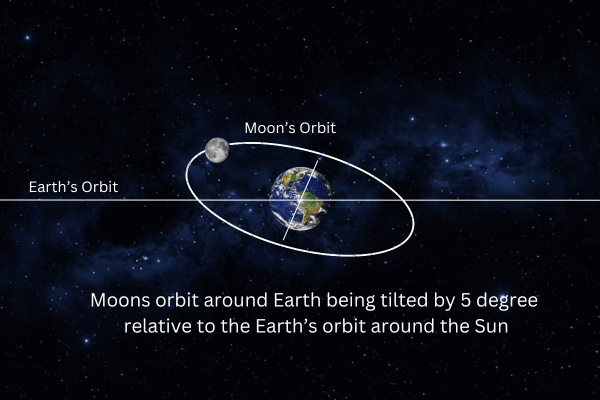
WHY SOLAR ECLIPSE ARE RARE
Solar eclipses are not common occurrences because it requires a precise alignment of the Sun, Moon, and Earth. The Moon’s orbit is tilted by approximately 5 degrees in relation to Earth‘s orbit around the Sun, which means that the Moon typically passes either above or below the Sun from our vantage point. The occurrence of a solar eclipse is contingent upon the Moon crossing the ecliptic plane at the appropriate time, specifically during the new moon phase, which sets the stage for an eclipse. Moreover, total solar eclipses are especially rare as they can only be seen within a narrow path where the Moon’s shadow is cast, rendering them a remarkable and infrequent phenomenon.
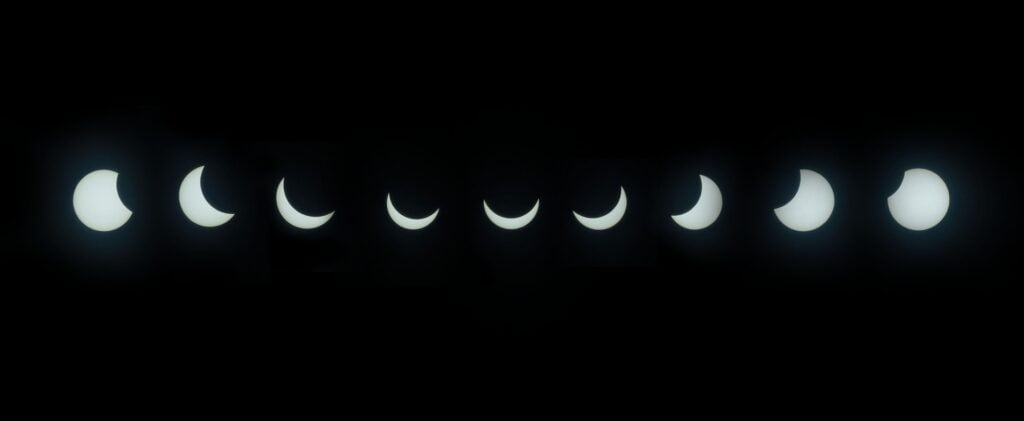
PHASES OF SOLAR ECLIPSE
There are five different phases in solar eclipse:
- At first contact, the Moon’s edge perfectly aligns with the Sun’s edge.
- The second contact marks the appearance of Baily’s Beads, caused by light passing through the Moon’s surface valleys, and the diamond ring effect, with almost the entire Sun’s disk covered.
- During totality, the Moon covers the entire Sun’s disk, revealing only the solar corona.
- At the third contact, the first bright light reappears and the Moon’s shadow moves away from the observer, potentially allowing the observation of another diamond ring.
- The fourth contact occurs when the trailing edge of the Moon no longer overlaps with the solar disk, indicating the end of the eclipse.
HISTORICAL SIGNIFICANT
Throughout history, solar eclipses have been deeply significant, often viewed as powerful signs or messages from the divine. The Babylonians and Egyptians, among other ancient civilizations, saw solar eclipses as warnings from gods or indicators of important events. In various cultures, eclipses were believed to represent battles among celestial entities, such as dragons or demons attempting to swallow the sun. These interpretations influenced decisions and actions, including the halting of conflicts, as seen in the war between the Lydians and Medes in 585 BC. Solar eclipses also played a critical role in driving scientific progress. For example, the solar eclipse of 1919 provided crucial evidence for Einstein’s theory of general relativity. Additionally, solar eclipses have been instrumental in the discovery of new elements and in enhancing our understanding of the sun’s structure. Thus, solar eclipses have not only influenced cultural and religious beliefs but have also significantly contributed to the advancement of scientific knowledge.
SAFETY DURING A SOLAR ECLIPSE
Protecting Your Eyes
- For safe viewing, use special-purpose solar filters such as eclipse glasses or handheld solar viewers to look directly at the sun during a solar eclipse. These filters are designed to block harmful UV and visible light.
- Do not use homemade filters like ordinary sunglasses or those made from materials such as CDs or smoked glass, as they are unsafe and can cause eye damage.
- If you don’t have eclipse glasses, you can safely watch the eclipse by projecting the image onto a surface using a pinhole projector or a telescope.
Other Safety Guidelines
- Stay updated on the timing and phases of the eclipse and only look directly at the sun during totality.
- Even during an eclipse, protect your skin from the sun’s harmful rays by wearing sunscreen and a hat.
- Before viewing the eclipse, ensure you are in a safe and easily accessible location and avoid crowded areas or places with obstructions.
- Always supervise children while they view an eclipse and ensure they use appropriate eye protection.
Remember: Directly looking at the sun during a partial or annular eclipse, even if it’s partially covered, is never safe. Only during totality, when the sun is completely obscured by the moon, is it safe to view without protection.
CONCLUSION
Solar eclipses, which occur when the moon moves between the Earth and the sun, causing the sun’s light to be blocked, are the remarkable natural occurrences. These instances are not just visually impressive but also present valuable opportunities for scientific research. They enable astronomers to observe the sun’s outer atmosphere, known as the corona, which is normally hidden by the sun’s intense light. Furthermore, solar eclipses can contribute to scientists’ understanding of the Earth’s atmosphere and climate. Even though these astronomical events are infrequent, they afford a distinctive and unforgettable experience for those fortunate enough to witness them.


Pingback: What is Lunar Eclipse?: Definition, Diagram, Types, & Phases
Pingback: Types of Solar Eclipse - ASTRONOMY ADVENTURE
Pingback: Types of Lunar Eclipse: A Detailed Guide About It!!